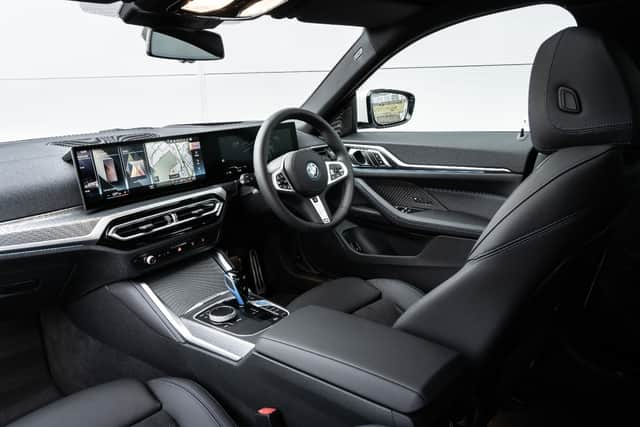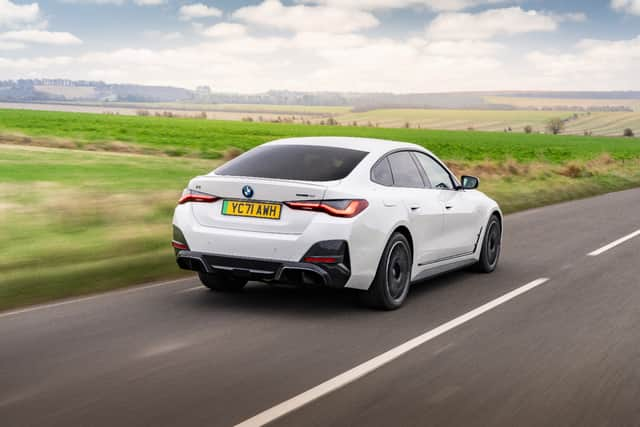BMW i4 review: Conventional looking EV proves you can have best of both worlds


BMW’s first attempt at an electric car - the i3 - was a wild and utterly unique creation.
From its weirdly boxy styling and unconventional interior design to its suicide doors it deliberately stood out and even today looks brilliantly futuristic.
Advertisement
Advertisement
Which makes it about as far removed from BMW’s latest EV as it’s possible to get.
If the i3 was all about standing out from the rest of the BMW range, the i4 is all about blending in.


In fact, if it wasn’t for the blue flashes along the doors and the blanked off “grille” you’d be forgiven for thinking that you were looking at just another 4 Series Gran Coupe.
Yet, despite its shrinking violet appearance this is an important car for BMW. It’s here to take on the Tesla Model 3 which has threatened the 3 Series’ position as the king of the compact exec saloon, as well as other electric rivals like the Polestar 2.
Advertisement
Advertisement
And so, in a way, it makes sense that it doesn’t look anything out of the ordinary. It’s the electric saloon/hatchback for people who want a 3 or 4 Series but feel they need to move to an EV, whether that’s for environmental reasons or because it makes financial sense from a company car standpoint.
Compared with the “challenging” iX and the minimalist Tesla Model 3 it looks incredibly conventional but for many buyers that’s exactly what they want. Some people want the space-age revolutionary approach and some people want something familiar. And the i4 certainly looks familiar.


Like the exterior, the interior is clearly related to BMW’s existing combustion-powered range.
The cabin isn’t a straight lift from the 3 or 4 Series but the i4 does have a lot in common with them. Most of the controls and interior parts are shared with the ICE models, so there’s lots of glossy black plastic and chrome-coloured highlights with knurled finishes. Predictably, the fit and finish is first class and leaves the Model 3 looking and feeling decidedly cheap in comparison.
Advertisement
Advertisement
The most clear difference is the new twin-screen array which blends 14.9-inch infotainment and 12.3-inch instrument displays into a continuous curved panel. Powered by the latest iDrive system it’s burdened by too many menus but is easily controlled by the rotary dial. Polestar’s Android-based system still leads the way in blending high-tech with user-friendly.
As well as looks, the i4 shares its whole platform with the 3 and 4 Series and that, unfortunately, means compromises in the cabin. While ground-up EVs can have flat floors and wide open spaces between interior elements, the i4 still has a huge transmission tunnel that leaves it feeling cramped, particularly in the rear seats. On the plus side, its 470-litre boot is ahead of both rivals.
While the basic platform is the same, the i4’s drivetrain is all new. At its centre is a 80kWh battery pack powering either a single rear-mounted motor in the eDrive40 or a pair of motors in the M50.
As the name suggests, the M50 is the performance model tuned by the famous M Division. Think of it as a sort of electric M3. Its two motors drive all four wheels and put out a combined 537bhp compared to the 335bhp of the eDrive40.
Advertisement
Advertisement
The M50 certainly doesn’t want for performance. Set it to full sport mode to unlock all the power and it will cover the 0-62mph run in 3.9 seconds with the usually seamless urge of all EVs. A Model 3 Performance will do 0-60mph in 3.1 but that’s only a fraction of the story. The M50 feels more than fast enough in a straight line and once you get to some corners, BMW’s experience shines through with better steering, grip and control that reminds you this is a car from M Division.
The 40 might lack the extra motor, adaptive suspension and additional bracing and stiffening of the M50 but that doesn’t mean it’s a slouch. Even the “lesser” i4 will cover 0-62mph in less than six seconds and is better to drive than the Model 3 or Polestar 2. In fact, the lighter car is arguably more delicate than the M50, with more involving handling from its rear-drive setup, more feedback from the steering and a more comfortable ride.


The 40 also offers a better range. Its 365-mile maximum compares with 318 for the M50. A Model 3 Long Range manages an official 374 while the longest range Polestar will do 336.
Both versions of the i4 offer 200kW charging, meaning if you can find one of the latest 350kW charging stations you can add up to 102 miles to the 40 or 87 to the M50 in just 10 minutes.
Advertisement
Advertisement
As with range, the Model 3 has a slight edge here, with 250kW capability via the - for the moment - exclusive Supercharger network.
As an EV, the Tesla has the edge due to its impressive range, more spacious feeling interior and the integration between the car and the charger network. But as a car, the i4 is the better option. It’s better to look at, vastly better to drive and has the user-friendly controls and premium materials you expect from Bavaria’s finest. If you want to switch to an EV with the absolute minimum change to your driving experience, the i4 could be the way to go.


BMW i4 eDrive40 M Sport
Price: £53,405; Motor: Single synchronous motor; Battery: 80.7kWh; Power: 335bhp; Torque: 317lb ft; Transmission: Single-speed, rear-wheel-drive; Top speed: 118mph; 0-62mph: 5.7 seconds; WLTP range: 365 miles; Consumption: 3.1-3.88 miles/kWh; Charging: Up to 200kW
